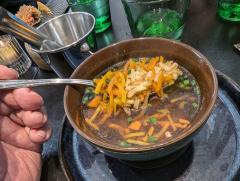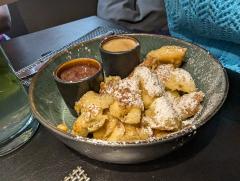 Saturday 18 May would have been my mother's 90th birthday; she'd have been thrilled to know that we were to see a Mozart opera in his adopted hometown, in one of the finest opera houses in the world!
Saturday 18 May would have been my mother's 90th birthday; she'd have been thrilled to know that we were to see a Mozart opera in his adopted hometown, in one of the finest opera houses in the world!
We had breakfast at our Prague hotel and then took the 4-hour 08:44 RegioJet to the Wien Hauptbahnhof in Vienna. Our friends Owen and Brigitte were to take a train down from Nuremberg, arriving two hours later, and we would meet up for dinner before the opera. Alas! They got their wires crossed and ended up on different trains! We joined Brigitte on time, and Owen arrived two hours later at the dinner restaurant with his suitcase, and everything was back on track.
 Vienna reminded me of Paris. It's one of the world's great cities, with long and interesting history, unparalleled musical heritage, fine architecture, broad straight boulevards, wide sidewalks, and interesting shopping and dining. It was all clean. But, as in Paris, I felt alternately like an ant walking across some grand structure that my mind would never encompass, or else like an actor who had walked into someone else's play. There were ritzy boutiques full of glamorous things by designers I had faint recollection of and silly things for wealthy people. I remember a flashy display case full of fine silver tableware, and in the middle was a jar of Nutella - with a special custom silver top! So I couldn't shake the sense, at least in the downtown areas where we walked, that I just couldn't connect with the city on a personal level. In New York you can shop at Lord and Taylor and then get a hot dog from the Sabrett's cart on the sidewalk. Vienna had the fine shopping but not the pushcarts.
Vienna reminded me of Paris. It's one of the world's great cities, with long and interesting history, unparalleled musical heritage, fine architecture, broad straight boulevards, wide sidewalks, and interesting shopping and dining. It was all clean. But, as in Paris, I felt alternately like an ant walking across some grand structure that my mind would never encompass, or else like an actor who had walked into someone else's play. There were ritzy boutiques full of glamorous things by designers I had faint recollection of and silly things for wealthy people. I remember a flashy display case full of fine silver tableware, and in the middle was a jar of Nutella - with a special custom silver top! So I couldn't shake the sense, at least in the downtown areas where we walked, that I just couldn't connect with the city on a personal level. In New York you can shop at Lord and Taylor and then get a hot dog from the Sabrett's cart on the sidewalk. Vienna had the fine shopping but not the pushcarts.
 Vienna is home to Frey Wille jewelry, and their flagship store is just off the Stephansplatz and around the corner from Mozart's apartment. She had fallen in love with their beautiful gold-and-enamel jewelry in Paris on our first European trip in 2015. The day was Saturday and they would be closed on Sunday and Monday, so naturally our first stop had to be there before closing time. While Lorna and Melissa shopped in that store, I explored the Stephansplatz, with the magnificent St Stephen's cathedral and the dozens of medieval-looking vendor stalls crowded around it, most selling decidedly non-medieval wares. It was a beautiful afternoon for exploring!
Vienna is home to Frey Wille jewelry, and their flagship store is just off the Stephansplatz and around the corner from Mozart's apartment. She had fallen in love with their beautiful gold-and-enamel jewelry in Paris on our first European trip in 2015. The day was Saturday and they would be closed on Sunday and Monday, so naturally our first stop had to be there before closing time. While Lorna and Melissa shopped in that store, I explored the Stephansplatz, with the magnificent St Stephen's cathedral and the dozens of medieval-looking vendor stalls crowded around it, most selling decidedly non-medieval wares. It was a beautiful afternoon for exploring!
 When they were finished, we walked about two blocks to the Mozart apartment and museum. The apartment is on the second floor (by American reckoning) of a building with maybe four floors. The ground floor was for admissions, a cloakroom, and a dreary little "cafe" with vending machines and cheap tables. The rest of the place had interesting exhibits, one floor about life in Mozart's Vienna, and another close look at his music. My favorite was an exhibit that showed multiple displays of the same part of the same opera, but very different productions. A central display showed the lyrics, and a switch allowed us to hear and see the same bit in different productions. The apartment had the rooms but not the contents of the apartment. All of Mozart's belongings have long since disappeared, lost in an age when historic preservation was nobody's priority. Some parts were recreated to some degree, but it was mostly about the man and his life and work. There was an interesting collection of Freemasonry artifacts from the period that helped to explain the bizarre "Magic Flute" opera.
When they were finished, we walked about two blocks to the Mozart apartment and museum. The apartment is on the second floor (by American reckoning) of a building with maybe four floors. The ground floor was for admissions, a cloakroom, and a dreary little "cafe" with vending machines and cheap tables. The rest of the place had interesting exhibits, one floor about life in Mozart's Vienna, and another close look at his music. My favorite was an exhibit that showed multiple displays of the same part of the same opera, but very different productions. A central display showed the lyrics, and a switch allowed us to hear and see the same bit in different productions. The apartment had the rooms but not the contents of the apartment. All of Mozart's belongings have long since disappeared, lost in an age when historic preservation was nobody's priority. Some parts were recreated to some degree, but it was mostly about the man and his life and work. There was an interesting collection of Freemasonry artifacts from the period that helped to explain the bizarre "Magic Flute" opera.
 We walked to dinner at Führich, a fine restaurant known for honoring traditional Austrian foods and supporting local farmers. We had a reservation for five people, hoping that Owen's train would be on time and he'd be able to join us. Everything worked out!
We walked to dinner at Führich, a fine restaurant known for honoring traditional Austrian foods and supporting local farmers. We had a reservation for five people, hoping that Owen's train would be on time and he'd be able to join us. Everything worked out!
I started out with the Frittatensuppe, a perfect beef consomme with root vegetables and shreds of sliced crepe. It's a classic recipe that I had read about, but it's usually translated as soup with sliced pancake. It's hard to imagine a fluffy American buttermilk pancake being anything but a gooey mass in a bowl of soup, so I was glad to see what it really was in practice.

Owen and I had the Wienerschnitzel. Austrians love their schnitzels (veal, pork, and chicken, hammered out so thin as to double or triple in area for fast crispy cooking over high heat.) and the king of them is the Wiener schnitzel. Wien is the Austrian name for Vienna, and the famous schnitzel of Wien is always made with veal.
Lorna had trout. Vienna is nowhere near the sea, and seafood can be imported now but it's not a big part of Austrian cuisine. They farm trout, so she did not have to go hungry waiting for Italy. Of course it was prepared perfectly.
 Brigitte and Melissa had the pumpkin risotto. The central/southern region of Styria produces many pumpkins and much high-quality pumpkin oil, so these ingredients are more common in Austrian cuisine than you might expect.
Brigitte and Melissa had the pumpkin risotto. The central/southern region of Styria produces many pumpkins and much high-quality pumpkin oil, so these ingredients are more common in Austrian cuisine than you might expect.
Brigitte and Lorna finished with the Kaiserschmarrn. That's spelled correctly, with the rr near the end. It means "the Kaiser's mess" and it looks rather messy. It's a pile of fluffy pancakes torn apart, dusted with powdered sugar and served with fruit compote. It's hugely popular, there's even a chain of coffee houses called Kaiserschmarrn!
 After dinner it was a quick five-minute walk to the Staatsoper for La Nozze de Figaro. This was one of the key events of the whole trip. It was a "bucket list" item for me to see a Mozart opera in Vienna at this opera house, and I had signed up to buy the tickets eight months before they went on sale in March. The flight to Prague and everything else that we had done had occurred when it did because we had to be in Vienna for this show.
After dinner it was a quick five-minute walk to the Staatsoper for La Nozze de Figaro. This was one of the key events of the whole trip. It was a "bucket list" item for me to see a Mozart opera in Vienna at this opera house, and I had signed up to buy the tickets eight months before they went on sale in March. The flight to Prague and everything else that we had done had occurred when it did because we had to be in Vienna for this show.
The opera house is a gorgeous structure, all white and gold with fine sculptures and fancy work everywhere. The orchestra, the costumes, the sets, and especially the singers were splendid, both in voice and in acting ability. The Vienna Staatsoper is one of the premier opera houses in the world, so they can afford the best productions and the best singers. The whole thing was amazing! At the end, Lorna and I agreed it was the best opera we had ever seen in person.
 One of the most iconic desserts in a city renowned for desserts is the Sachertorte, invented by a young Franz Sacher in 1832 to serve at an event hosted by Prince Metternich. Years later he opened the Hotel Sacher across the street from the Staatsoper, so after the show we went there to try this celebrated masterpiece. The five of us took advantage of the opportunity to try a whole array of pastries: Sachertorte, Sacher Cube, Cheese Strudel, Kugelhopf, and Vienna specialty Melange Coffee. Alas! We were mostly disappointed. The desserts were all well made and attractively presented, but I can't say that the Hotel Sacher's versions of these pastries are worth the voyage of thousands of miles. Fortunately we had other, better versions in the coming days!
One of the most iconic desserts in a city renowned for desserts is the Sachertorte, invented by a young Franz Sacher in 1832 to serve at an event hosted by Prince Metternich. Years later he opened the Hotel Sacher across the street from the Staatsoper, so after the show we went there to try this celebrated masterpiece. The five of us took advantage of the opportunity to try a whole array of pastries: Sachertorte, Sacher Cube, Cheese Strudel, Kugelhopf, and Vienna specialty Melange Coffee. Alas! We were mostly disappointed. The desserts were all well made and attractively presented, but I can't say that the Hotel Sacher's versions of these pastries are worth the voyage of thousands of miles. Fortunately we had other, better versions in the coming days!
